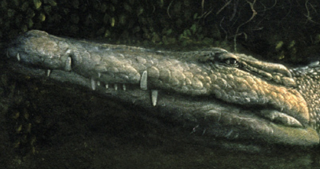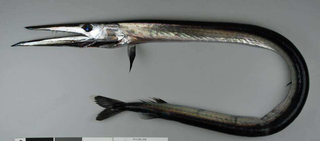
Tetrahymena is a genus of free-living ciliates, examples of unicellular eukaryotes. The genus Tetrahymena is the most widely studied member of its phylum. It can produce, store and react with different types of hormones. Tetrahymena cells can recognize both related and hostile cells.

Leuciscus is a genus of fish belonging to the family Cyprinidae. They are inland water fishes commonly called Eurasian daces. The genus is widespread from Europe to Siberia. Species broadly distributed in Europe include the common dace Leuciscus leuciscus and the ide L. idus.

Pristichampsus is a non-diagnostic and potentially dubious extinct genus of crocodylian from France and possibly also Kazakhstan that is part of the monotypic Pristichampsidae family. As the type species, Pristichampsus rollinatii, was based on insufficient material when described in 1831 and 1853, the taxonomic status of the genus is in doubt, and other species have been referred to other genera, primarily Boverisuchus.

The Lessepsian migration is the migration of marine species along the Suez Canal, usually from the Red Sea to the Mediterranean Sea, and more rarely in the opposite direction. When the canal was completed in 1869, fish, crustaceans, mollusks, and other marine animals and plants were exposed to an artificial passage between the two naturally separate bodies of water, and cross-contamination was made possible between formerly isolated ecosystems. The phenomenon is still occurring today. It is named after Ferdinand de Lesseps, the French diplomat in charge of the canal's construction. The term was coined by Francis Dov Por in his 1978 book.

Ostracion is a genus of marine ray-finned fishes belonging to the family Ostraciidae, the boxfishes. These fishes are found in the Indo-Pacific region as far east as the eastern Pacific coasts of the Americas.

The yellow boxfish is a species of marine ray-finned fish belonging to the family Ostraciidae, the boxfishes. This species is found in reefs throughout the Pacific Ocean and Indian Ocean as well as the southeastern Atlantic Ocean. Recorded occasionally since 2011 in the Levantine waters of the Mediterranean Sea which it likely entered via the Suez Canal, it is a species appreciated in the aquarium trade.

Trachiniformes is an order of percomorph bony fish, whose contents are traditionally placed in suborder Trachinoidei of Perciformes.

Anotopterus vorax, the Southern Ocean daggertooth, is a species of daggertooth. It inhabits the Southern Ocean circumglobally.

Acroplous is an extinct genus of dvinosaurian Temnospondyli within the family Eobrachyopidae.

Champsodon is the sole genus in the family Champsodontidae. These fishes, the crocodile toothfishes, are native to the Indo-Pacific region.

Acanthostomatops is an extinct genus of zatracheidid temnospondyl from the Lower Permian Döhlen Basin of Saxony.
Gerald Robert "Gerry" Allen is an American-born Australian ichthyologist. His career began in 1963, when he spent a semester at the University of Hawaii, where he also received a PhD in marine zoology in 1971. In 1972, Allen wrote his doctoral thesis on the systematics and biology of the anemone fish.

Jaydia queketti, the spotfin cardinal or signal cardinalfish, is a species of ray-finned fish from the Indian Ocean, it is a member of the family Apogonidae. It has colonised the eastern Mediterranean Sea by way of the Suez Canal since 2004.

Leuciscus vorax, sometimes known as the Tigris asp or Mesopotamian asp, is a freshwater fish of the Cyprinid family. It is native to the Tigris-Euphrates basin and Orontes River in Iran, Iraq, Syria, and Turkey.
The gaper is a species of crocodile toothfish belonging to the family Champsodontidae. It is found in the Indian Ocean along the coast of East Africa from Kenya to South Africa and off the Seychelles and Mauritius. This species has entered the Mediterranean Sea, most likely as a Lessepsian migrant, through the Suez Canal, being first recorded in 2012. Gapers occur in large shoals which move from deep water to the surface at night.

Champsodon nudivittis, also known as the nakedband gaper, is a species of marine ray-finned fish, a crocodile toothfish belonging to the family Champsodontidae. It occurs in the Indo-West Pacific from Madagascar, Indonesia, the Philippines and Australia. It was recorded in 2008 in Iskenderun Bay on the Mediterranean coast of Turkey, likely introduced by ballast water. It is now commonly found from Greece to Israel in the eastern Mediterranean Sea.
Creedia bilineata is a species of sandburrowers found in the Northwest Pacific Ocean around Japan. This species reaches a length of 3.2 cm (1.3 in).













